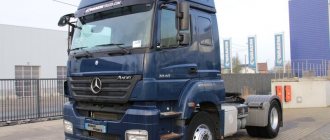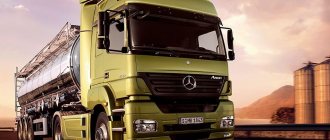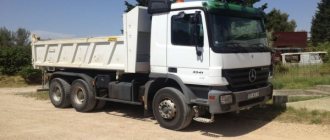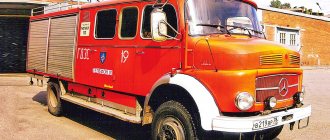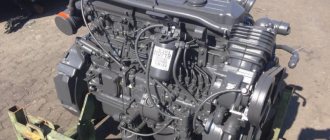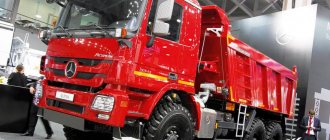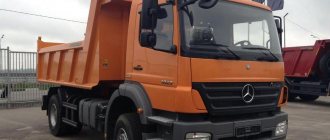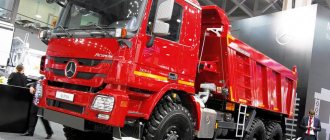In contrast to the universal Unimogs and heavy off-road Zetros, the Axor Mercedes-Benz is a family of trucks from 18 to 26 tons for medium-haul transportation under normal road conditions, which began to be produced by the then Daimler Chrysler AG in 2001, with restyling through 3 years and updating the models in another two.
Mercedes-Benz Axor with a fairly high load capacity is very economical. Including due to savings on the vehicle's own weight and low fuel consumption, they are reliable in operation and, in the case of a cab with a sleeper, quite comfortable.
Mercedes-Benz Axor
In contrast to the universal Unimogs and heavy off-road Zetros, the Axor Mercedes-Benz is a family of trucks from 18 to 26 tons for medium-haul transportation under normal road conditions, which began to be produced by the then Daimler Chrysler AG in 2001, with restyling through 3 years and updating the models in another two.
Mercedes-Benz Axor with a fairly high load capacity is very economical. Including due to savings on the vehicle's own weight and low fuel consumption, they are reliable in operation and, in the case of a cab with a sleeper, quite comfortable.
Mercedes-Benz axor
In addition to transporting goods over long, but not very long distances, the MB Axor is also universally applicable in the construction industry. And due to compliance with Euro-5 standards and reduced dimensions, it can be used without restrictions in cities and towns, since their motto is: “Weigh less - transport more”
The range of these trucks is varied:
- 2-axle truck tractors.
- 2-axle 18-ton trailerless trucks with four-by-two and four-by-four wheel arrangements.
- 3-axle heavy trucks for 26 tons with wheel arrangements of six by two and six by four.
Their equipment is also varied:
- Tipping bodies.
- Auto platforms.
- Dumper type dump trucks.
- Special bodies.
Restrained demand for the Mercedes-Benz Axor 1835 due to a number of technical shortcomings led to the appearance of the Mercedes-Benz Axor 1836, and then an even more advanced car - the 2011 Mercedes-Benz Axor 1840 LS.
The following options further increase the profitability of certain types of Mercedes-Benz Axor:
- Powershift transmission compatible with 360 l/s engines.
- Start-stop system (for engines with a power of 326 l/s).
The parallel frame of the Mercedes Axor perfectly withstands extreme loads; the corresponding holes made in advance in the required places make the installation and reinstallation of attachments, including a different size or an additional fuel tank, easier.
To achieve Euro 5 requirements, BlueTec technology with selective catalytic reduction is used, when a special AdBlue reagent is injected into the exhaust pipe and nitrogen oxides and ammonia become nitrogen and water vapor common in the Earth's atmosphere. The oil level is checked using instruments.
General characteristics of the Mercedes Actros family
Mercedes Actros are quite popular heavy-duty vehicles and truck tractors that embody all the advantages of German technology. This family includes trucks with a load capacity of up to 41,000 kilograms. The Actros series has been the standard used for long-distance transport for several years.
Aktros cars have the following advantages:
- pleasant appearance and stylish design;
- convenient and comfortable cabin;
- high security;
- high-quality assembly;
- economy and environmental friendliness;
- the basic equipment is very rich;
- a huge range of transmissions and engines.
In this review, it is worth highlighting separately the characteristics of all four generations of Mercedes-Benz-Actros trucks.
First generation
The initial batch came out in 1995 in the form of truck tractors, which had different wheel formulas: for example, 6 × 6, 6 × 4, 2 × 4 or 6 × 2. These vehicles received only two types of power units, their power “walked” between 310 and 460 horsepower.
The PLD system, which was responsible for the supply of fuel, was perceived extremely negatively by drivers, since it was not only picky about the brand of fuel, but also often failed.
The first batches of trucks had manual transmissions, but later they added Telligent Gearbox, a so-called electronic system with 16 gears.
Tractor "Aktros" 1st generation
The Germans tried to keep up with their market rivals and provided Mercedes-Benz tractors and dump trucks with different types of cabs.
By the way, Mercedes was one of the first companies among those that installed cabins with sleeping places. Such cabins are called Mega Space.
Despite all the shortcomings that existed with the electronic fuel system, the first generation tractors were able to sell in fairly large quantities. The company produced special versions for the USA and Russia, which also influenced its success.
Russian models had a reinforced chassis, redesigned thermal insulation and a line heating function.
Second generation
In 2000, Mercedes Benz decides to release a large vehicle with changes. In fact, it was an improved version of the first series with improvements to faults and greater reliability.
The appearance of the car did not change; however, it proved to be stronger, but no less problematic.
Already in 2001, assembly line production of second-generation cars began. In addition to reliability, standards regarding the environmental friendliness of trucks were improved, the inside of the cabin was changed, which allowed drivers to feel more comfortable, and vehicle controllability also improved.
Model "Aktros" 2nd generation
The truck is still equipped with 6-cylinder V-shaped power units, but in this case they already met European standards.
The engine service interval was increased, now the oil was changed every 100 thousand kilometers.
The characteristics of the second generation cargo tractors made it possible to produce up to 580 horsepower.
In 2004, such a car from Mercedes-Benz received a rather prestigious award, which made it possible to get rid of the stigma of an “unreliable and problematic” car that the company received after the release of the first generation. The tractors were recognized as the best trucks of 2004 throughout Europe.
There were several types of cabins to choose from, depending on the wishes of the drivers. You could choose a cabin without a berth, a standard cabin, useful for “short” trips, or an improved one, with more space.
"Aktros" II generation on the way
The model also received new ones:
- front springs;
- bridge;
- steering.
All this helped increase the stability of the tractor on the road.
The company continued to fight drivers' opinions about the unreliability of cars, and already from the second generation they succeeded.
Third generation
Only three years later, in 2008, the company introduced a new version of the truck. The changes affected not only the external components of the machine, but also the internal structure.
The cabin was made larger, and the truck itself became more beautiful and stands out on the roads. An enlarged brand logo, sharp vertical headlights and a dynamic bumper - all this characterizes the third generation tractor.
The Mercedes-Benz Actros 3341 truck tractor is the most popular of all third-generation vehicles.
Model 3341
In 2010, it began producing tractors for Russia at the KamAZ and Daimler plants in Naberezhnye Chelny.
In 2008, the company managed to win the title of “Truck of the Year” again.
Mercedes-Benz engineers decided that it was better to modernize old elements than to invent something new, and this was one of the right decisions. The improved radiator grille looks like a complete picture together with the cabin.
The visors now have three panels and can be adjusted offline, which is very convenient for the passenger and driver. The lower bumper skirt has aerodynamic openings, and the headlights have a chrome trim.
Overall, the car began to look cooler and much more expensive. Sleeping berths with orthopedic mattresses were, of course, a good decision by the company.
Cabin interior
Regarding the technical part, it must be said that changes have occurred here too.
The third generation tractor was equipped with the same V-shaped engine with 8 cylinders. In terms of power, there is also plenty to choose from, the 12-liter engine produces up to 476 horsepower, and the 16-liter as much as 598.
The basic equipment has an automatic transmission. By the way, this is the first model that comes with a 12-speed robotic transmission as standard.
The new air suspension copes well with road irregularities.
In general, the third generation model turned out to be very bright and functional; it managed to completely get rid of the characteristics of an “unreliable and problematic” car and strengthen its position as the best tractor.
The third generation model 3341 is still chosen by many truck companies for their drivers.
Fourth generation
Talk about new generation machines appeared in 2012, and this model promised to become the most ambitious, more than $1 billion was poured into it, and the investment turned out to be truly justified.
The modular configuration system received three packages, each of which was distinguished by its own list of equipment. Moreover, they were applied to both the interior and safety, and the body did not go unnoticed.
Externally, fourth-generation cars began to look much more powerful, received several modifications to the chassis, cab options and wheel formulas of 4 × 2, 6 × 2 and 6 × 4.
Model "Aktros" 4th generation
Now the tractor can be tailored to specific needs and used in an even wider area. Thanks to the use of aerodynamic smooth lines, it was possible to significantly reduce fuel consumption, compared with models of previous generations.
The salon has also undergone many changes. The driver's seat is positioned so that all instruments are now at arm's length: you no longer need to bend over to reach the car control buttons.
The SoloStar Concept is very convenient for two drivers on a trip.
The on-board computer now has a white backlight, an intuitively simple and clear menu, and a screen on which images are displayed. This is true for trucks that are equipped with a rear camera; the driver will be able to see the image directly on the computer monitor.
The driver's seat has 4 types of seats, and the partner's seat has 3.
Driver's seat
In 2012, the company began producing special seats that have a massage function. Pressing a button activates seven airbags that will relax the driver's muscles.
The universal chassis made it possible to use the car as a motor home, which allowed the company to open up new customers.
Exterior
Everything is done for intensive work and good rest. Mercedes-Benz Axor has 5 cab options:
- Short (S) just over one and a half meters.
- Extended - 1.8 m.
- With one sleeping place - more than 2.2 m.
- With sleeping places for two people.
- The L cab with a high roof - increased comfort, with easy entry, spacious compartments and shelves for various things - is a truck driver’s “dream”.
Adequate levels of safety are ensured by excellent performance of Telligent brakes, clear glass headlights and side mirrors that keep blind spots to a minimum, as well as active safety devices.
Cabin. Execution options
The exterior design of the Mercedes-Benz Axor cabin clearly demonstrates the unity of beautiful form and functionality that is characteristic of all Mercedes-Benz commercial vehicles. Regardless of the selected cab type, the headlights and bumper design are the same for all Axor versions. The Mercedes-Benz Axor truck is equipped with headlights with today's popular transparent glass lenses, which combine an attractive design with optimal lighting performance. Xenon headlights can be ordered upon request.
When driving, the driver will be able to appreciate the improved visibility of the Mercedes-Benz Axor, provided by the advanced mirror system. Speaking about the safety provided by the improved all-round visibility of the vehicle, it is worth recalling once again the protection of the side windows from dirt, which is provided by the improved fairings located on the front of the truck.
In the cabin of the Mercedes-Benz Axor, the driver and passenger will find completely new work areas. The Mercedes-Benz Axor truck offers a large selection of cab sizes. Depending on the application and engine installed, you can choose from a standard cab (S), a standard cab with a 180mm extension, a long cab (L) and a long cab with a high roof. The interior height of this most spacious cabin is 1,910 mm. For Axor versions with a 12-liter engine, the engine tunnel in the cabin is now 120 mm lower.
There is a choice of three options for finishing the front panel of the cabin, depending on the intended application.
We can safely say that in the new version, the Axor cabin in terms of comfort and ergonomics is as close as possible to the cabin of Actros cars that has already received universal recognition.
Interior
In the Mercedes-Benz Axor, the cabin is not much inferior to many Mercedes models in terms of its level of finishing and comfort. But it is distinguished by strict thoughtfulness and ergonomics. The basic kit includes a seat with air suspension.
The “Razvoznoy” interior option provides the opportunity to:
- Convenient movement inside the cabin to the nearby lower berth.
- Middle seat settings for third person.
- Equipped places for storing documents and similar important things.
- All important control points for systems not directly related to driving (heating, ventilation, etc.) are within close reach.
The “Comfort” interior option provides the opportunity to:
- Larger storage compartment under the dashboard.
- Pleasant to the touch “dashboard” finish.
- There are many possibilities for adjusting the positions of the seats, ventilation and heating with heat dissipation in the right places.
- Inclusion of anti-vibration elements in the cabin mount.
The cabin has a durable 2-point suspension. Which undoubtedly does not provide additional comfort, but it is more reliable and durable. To raise the cabin, you need to turn on the hydraulics by raising the corresponding flag and not twist, but swing the lever. Tuning of the cabin interior “little by little” is done by the drivers themselves.
Engines
Mercedes-Benz Axor are equipped with in-line 6-cylinder diesel engines of various formats - 6.37 l, 7.2 l and 12 l, as well as from 230 l/s to 428 l/s. This is a special class of Mercedes power plants with Euro 5 BlueTec technology and a Telligent control mechanism.
Mercedes Axor engine range:
- 2001 models (x23, x28, x33, xx36, xx40 and xx43).
- The 2006 model was equipped with Atego engines that meet Euro 4/5 standards (x24 instead of x23, x26 and x29 instead of x28).
The smallest engine in the line is the OM 906 LA (6.37 l). Its power is 231 l/s and 279 l/s, but the torque is impressive - 810 and 1,100 Nm, respectively. Average performance for the 7.2-liter OM 926 LA. Accordingly, 326 l/s and 1300 Nm. And this system is completed by a 12-liter trio of OM 457 LA impressive and practical engines with 428, 401 and 260 horsepower that comply with Euro-5 standards.
Optionally, these motors can be equipped with a device that automatically turns off and starts them independently, which is not only very economical, but also reduces the amount of harmful substances emitted into the atmosphere, which has been reduced by the corresponding advanced technologies.
Options
The Mercedes-Benz Axor 1840 LS truck tractor has the following basic equipment:
- L cab with tinted windshield, seats and rest area, windowless rear wall, wide-angle mirrors and matching headlights, essential tool kit.
- A multifunctional steering wheel, the necessary set of sensors and instruments, including a control display, tempomat and econometer, a special CD radio, power windows.
- Six-cylinder LA engine with a power of 401 l/s, with a 2-cylinder and 2-stage air compressor, manual gearbox G 221-9/16.2-1.0 GS1 and a maximum speed limiter of 90 km/h.
- Cabin ventilation and heating systems, as well as an outside temperature indicator.
- Equipment for advance heating of fuel. At the request of future owners, it is possible to install the following additional equipment:
- Cabin with a high roof, spoiler, air conditioning, sunroof, which can be controlled from the seat, clock and curtain.
- One or two beds (lower and upper).
- External transparent sun visor and front aerodynamic mirror.
- Additional cabin insulation, heater and air springs for extreme cold conditions.
- Lockable fuel tank with matching mesh filler and an additional 650L aluminum tank mounted on the right. Tank with AdBlue reagent 85 l.
- Engine design to comply with Euro 5 standards, including a muffler with an SCR catalyst.
- Wheels, 9.00×22.5, reinforced and wheel chocks.
- Halogen fog lights.
Special opinion
Background. In 2006, we tested a Chinese JAC HFC4181 KR1 tractor with the inscription on the windshield “Average fuel consumption - 18 l/100 km.” Then, I hope, we were able to show that such a consumption is possible for it only with an empty semi-trailer, and then at speeds of about 50 km/h. About two years later, Sasha Trokhachev spoke about the triumph of the third generation Mercedes-Benz Actros, which, with a Euro 5 engine using BlueTec technology and an automated Power Shift 2 gearbox, was awarded the Guinness Book of Records in the category of the most economical serial tractor as part of a road train with a gross weight of 40 tons. Average value fuel consumption was 19.44 l/100 km at an average speed of 80.17 km/h.
And so today is the day. Having assessed the results obtained after testing the Actros 1851, we were convinced that there was not even a hint of record values. So that there is no doubt about the reliability of our results, the table shows the data from the car’s on-board computer.
The absence of phenomenal economic indicators of an ordinary car indicates that a revolutionary redistribution among the items of the external thermal balance of the engine did not occur, and moreover, increasing environmental requirements is a stumbling block on this path. The very use of BlueTec technology suggests that further intervention in the engine’s operating process becomes impractical, and it is necessary to combat the toxicity of exhaust gases after the engine, using separate systems. The record dossier mentions that during the establishment process 119 liters of AdBlue reagent were consumed, which is another 0.94 l/100 km. And what expense item should take them into account?
This means that we are talking about the effective use of only that part of the fuel that is directly used to move the car. These are traditional measures to reduce aerodynamic drag and good tires, road and weather can provide decent performance. To evaluate their effect on reducing fuel consumption, it was not necessary to drive tens of thousands of kilometers during the week (801 laps of 12.5 km at the Italian Nardo test site). Such a show is designed to create the illusion of operational fuel consumption, which is out of the question. This will always only be movement at a high constant speed, at which the effect of measures to reduce aerodynamic drag is more significant, and there is also the possibility of priority adjustment of engine systems to the selected operating mode. But the use of special motor oil and, most likely, fuel with increased calorific value should be considered the final chord of the technical achievement that has taken place. Mercedes-Benz successfully used it for their advertising show. The question now is will other companies rise to the challenge? It’s not at all a fact that the record will stand if they make similar changes to their cars.
Technical characteristics of Mercedes-Benz Actros 1851 LS
| Wheel formula | 4x2 |
| Curb weight, kg | 8600 |
| Payload on SSU, kg | 9400 |
| Gross vehicle weight, kg | 18 000 |
| Gross weight of the road train, kg | 40 000 |
Engine:
| OM 502LA, V8 turbodiesel, BlueTec5 15,928,510 at 1800 min-1 2400 at 1080 min-1 |
| Clutch | MFZ 430 |
Transmission:
| Mercedes PowerShift 2, G281-12 12/2 |
| Front suspension | Dependent spring |
| Rear suspension | Dependent pneumatic |
| Brake system | Telligent, ABS+ASR |
| Front/rear brakes | Disc / pneumatic |
Tires
| 385/55 R22.5 315/70 R22.5 |
| Maximum speed, km/h | 90 |
| Fuel tank capacity, l | 2x650 |
Advantages and disadvantages
Mercedes-Benz Axor has significant advantages in the following points:
- The use of BlueTec technology and compliance with Euro 5 standards not only gives priority to entry into cities. But it will also help in the near future to avoid paying significant amounts in the form of taxes and fees for damage caused to the environment of Europe. There will also be no problems when updating the fleet of vehicles, and proceeds from the sale of used trucks will offset part of the costs of purchasing new ones.
- Economical. Up to 5% fuel savings due to innovations in the combustion process and up to 20% due to increased service intervals.
- Wide range of engines with proven BlueTec technology, ranging from 129 HP to 598 HP.
- A reliable gearbox is a 12-speed Power-Shift automatic with a tunnel crankcase, weighing half a centner less than a 16-speed Telligent gearshift transmission and 40 kg less than a 9-speed manual transmission.
In addition to the generally recognized disadvantage of budget versions of the Mercedes-Benz Axor, which do not have sleeping places, these trucks, according to reviews from owners, with whom reviews from drivers coincide, have some other disadvantages:
- For the construction industry, the absence of a 4-axle vehicle in the Mercedes-Benz Axor tractor model range is sensitive, since not every special body can be installed on a 3-axle chassis.
- Many people think that the side members, 7.5 mm thick, are too thin for the Mercedes-Benz Axor truck tractor, because even the budget Scania Griffin has almost 1 cm.
- The bearing in the generator gets stuck too often. True, increasing its power to 100 amperes puts everything in its place.
Advantages
First of all, it is a wide and interesting range of engines. All modern models, including the Mercedes-Benz Axor 1835, use the same engine - the OM 457LA - but this Iran Khodro Diesel Company-certified development has a variety of power settings. The Axor diesel is a 6-cylinder in-line 4-stroke engine, water-cooled. The use of an in-line cylinder arrangement is caused by an attempt to save fuel and lubricants, the success of which is evidenced by reviews of the Mercedes Axor.
More on the topic: Highway Star – Peterbilt 379
All new Mercedes Axor 1835-2543 engines are equipped with the BlueTec system. This original development by German engineers allows powerful diesel engines to reduce fuel consumption and pass standards (up to the upcoming Euro-6) without engine modifications. The BlueTec catalytic converter is a heat-resistant chamber in which a special catalyst oxidizes toxic gases NOx, CO, CH, turning them into nitrogen, carbon dioxide and water.
The cylinder block is cast, made of aluminum alloy, i.e. The cylinder head is a single element for all cylinders. Direct injection method - BoschPES. The crankshaft, which transmits the rotation further, is a high-precision forged element sitting on seven three-layer bearings. The structure is balanced by counterweights, which allows stabilizing engine operation. Without a significant increase in fuel consumption and reaches maximum Newton meters already at 1100 min−1. Depending on the engine type, the torque can take values from the range of 1200-2250 Nm.
In the photo of the Mercedes Axor, the cabin seems narrow, in reality everything is not so sad, but there are complaints about the lack of space.
- Compared to competitors with the same payload capacity, the Mercedes Axor wins by weight by several hundred kg (the Axor wins 250 kg even over another Mercedes model, the Actros).
- The lack of choice of main gear is compensated for by 6, 9 and even 16-speed gearboxes, each of which is equipped with a tunnel housing.
- The ABS system is unlikely to surprise anyone these days, but Telligent disc brakes work in tandem with it on the Mercedes Axor.
- Precise on-board electronics.
- All models, including the Axor 1840 LS, have a single axle with a hypoid main gear (higher load, quieter, smoother running).
Specifications
Mercedes-Benz Axor 1843 LS has the following technical characteristics:
- Country of origin: Germany.
- Production - a division of the Daimler AG "M-B" holding company
- Body and cabin type - truck tractor, 4*2 wheel arrangement, L-cabin.
- Number of seats - 2 or 3.
- Frame - Twisting ladder type.
- Engine - diesel, in-line, 6-cylinder, 12 l, injection type with turbocharging and direct injection, power 428 l/s and revolution of 2100 N/m.
- Fuel tank and fuel consumption - 650 l (possibility of installing an additional tank on the right). With an average consumption of 30 liters per hundred kilometers.
- The length of the tractor/cabin is 5.82/1.82 m.
- The height of the tractor/cabin is 3.2/2.6 m.
- The width of the tractor/cabin is 2.5/2.5 m.
- Ground clearance - 0.22 m.
- Total weight - 18 tons.
- Load capacity - 10.7 tons.
- Speed is specially limited to 90 km/h.
- Transmission: 12-speed Power-Shift automatic with tunnel housing.
- The brake system is 2-circuit pneumatic with automatic adjustment.
- Wheels and tires - 9.00×22.5 reinforced, 315/70R22.5.
- Service interval - up to 120 thousand km.
Exclusive – “Turbobrake”
One exclusive option is the "Turbobrake", which is available on request in addition to the standard auxiliary brake combination consisting of a constantly open throttle brake and a Mercedes-Benz Axor exhaust flap brake, which develops braking performance at engine speeds above 2000 rpm 450 kilowatts (612 hp) and in many cases replaces the heavier, more expensive secondary retarder. Compared to a retarder, Tubobrake means an increase in load capacity of 80 kg.
Price
The price of the new budget Mercedes-Benz Axor LS 1843 is 3.3 million rubles. But the price for the new Mercedes Axor 1840 2022 with a 2-bed extended cabin, a high roof and an aerodynamic body kit, which itself costs 3 thousand euros, already costs 5.6 million rubles.
Used Mercedes Axor trucks with a 12 liter engine, depending on the year of manufacture and with a mileage of around 1 million km, have different prices. For 0.85 million rubles. you can buy a car manufactured in 2006. And for 2.2 million rubles. — 2012 Mercedes-Benz Axor 2015 with tuning costs no less than 3 million rubles.
Promercedes.ru also has a public page on VKontakte. Join us!
Also Read:
UNIMOG all-terrain motorhome: Features Engines Pros and Cons
Review of the M271 Engine: History of Creation Characteristics Pros and Disadvantages
Mercedes-Benz Zetros motorhome: Characteristics Engines
Review of Mercedes 221: Car for the Boss
A-Class 180 Mercedes: Interior Exterior Pros and Cons Engine
Chassis
The frame, borrowed from the Mercedes-Benz Actros and specially adapted to the characteristics of the Axor, meets all the requirements for heavy distribution tractors, long-haul trucks carrying out domestic transportation and, of course, vehicles operating in the construction and public utilities sector. It is designed to withstand high loads and was designed using systems and CAD calculations using the finite element method. Despite its low weight, the frame meets the highest requirements in terms of flexural and torsional rigidity. Standard perforations for fastening crossbars and components are part of the process of unifying the design of vehicles.
All versions of the Mercedes-Benz Axor with leaf spring suspensions are equipped with parabolic springs. The standard shock absorbers and stabilizers are specially adapted to parabolic springs. The leaf spring suspension is mounted using maintenance-free rubber bearings that incorporate synthetic molecular components and therefore require neither central nor manual lubrication.
Various versions of the Mercedes-Benz Axor can be equipped with air suspension. In addition to leaf/air springs, fully air suspensions are also available. The air suspension provides precise axle control and excellent dynamic properties. The use of the Stabilenker device, which combines the functions of a guide system and a stabilizer, reduces weight and increases stability.
Mercedes-Benz Axors with air suspension are equipped as standard with the Telligent frame height adjustment system, which ensures easy raising and lowering of the frame.
Electronic control of the braking process provides the Axor truck with comfortable braking like a car, regardless of the load level. The brake pedal travel ensures constant deceleration of the vehicle or the entire road train, regardless of the load level.
Thanks to the high proportion of maintenance-free or maintenance-free components, service costs have been significantly reduced.
